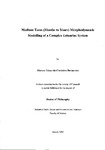Medium-Term (Months to Years) Morphodynamic Modelling of a Complex Estuarine System
| dc.contributor.author | Bernardes, Marcos Eduardo Cordeiro | |
| dc.contributor.other | Faculty of Science and Engineering | en_US |
| dc.date.accessioned | 2013-09-17T12:58:40Z | |
| dc.date.available | 2013-09-17T12:58:40Z | |
| dc.date.issued | 2005 | |
| dc.identifier | NOT AVAILABLE | en_US |
| dc.identifier.uri | http://hdl.handle.net/10026.1/1813 | |
| dc.description.abstract |
This contribution focuses on the medium-term (months to years) morphodynamic modelling of natural estuaries. A 2D morphodynamic model based on the Telemac system was calibrated and validated using extensive field measurements' at Teignmouth (UK). Statistical tools indicate that the model is capable of predicting the observed hydrodynamics with 'good' accuracy, given that measurement noise is removed. Despite some qualitative agreement, morphological predictions show a more limited skill; consistent with the current 'state of the art' in this area of scientific research. The typical long simulation times associated with process-based morphodynamic models are optimised through the successful implementation of an input reduction approach, adapted from Latteux (1995). The technique is shown to reduce the model run times by up to 85% without a significant loss in accuracy. Bathymetric surveys spanning 2 years (December 2002 to November 2004) at Teignmouth have clearly demonstrated a seasonal variability in the sediment volumes within the estuary, with accretion in the relatively energetic winter periods and erosion during the quiescent summer months. The net longer-term trend over this period is accretionary with average seabed accumulation rates of 20 cm.year"'. It is demonstrated that i f the wave stirring effect is neglected, the predictions carried out with a single grain size do not replicate the observed sediment import to the estuary from the neighbouring coastal region, due to the ebb dominated tidal regime found at Teignmouth. The importance of the combined effects of wave stirring and mixed grain sizes on reproducing the sediment import processes is confirmed by the Brier skill scores. Model predictions show a high influx of suspended sediment into the estuary in the presence of wave stirring effects at the coastal region. These sediments are advected into the estuary during the flood phase and are rapidly deposited at the outer estuary, since lag effects are neglected. The sediment input is predicted to be dominated by the finer sediment fractions (primarily silts and clays) although in very energetic conditions even granule-sized sediments can enter the estuary. Starting from an isotropic sediment distribution, a realistic spatial redistribution of sediment grain sizes is predicted, with sediments generally fining towards the shallower and upper regions of the estuary, whilst coarser grains were concentrated seawards. | en_US |
| dc.language.iso | en | en_US |
| dc.publisher | University of Plymouth | en_US |
| dc.title | Medium-Term (Months to Years) Morphodynamic Modelling of a Complex Estuarine System | en_US |
| dc.type | Thesis | |
| plymouth.version | Full version | en_US |
| dc.identifier.doi | http://dx.doi.org/10.24382/3553 |
Files in this item
This item appears in the following Collection(s)
-
01 Research Theses Main Collection
Research Theses Main


